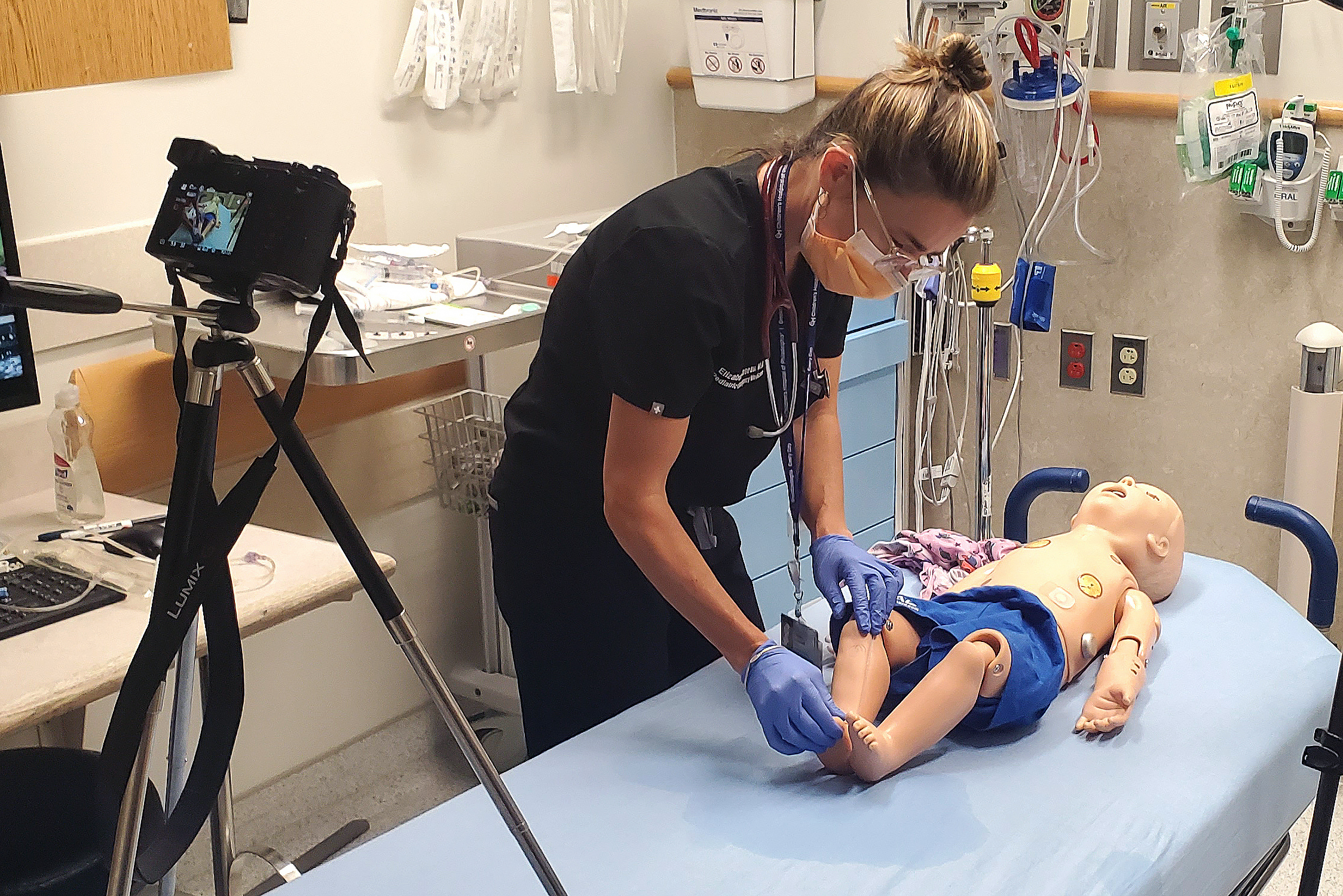It’s late at night in the hospital, and you’ve just arrived for your emergency department shift. Monitor beeps punctuate the murmur of hushed voices and hurried footsteps. Suddenly, you hear the skid of gurney wheels down the hallway as EMTs rush an infant into the room. The child’s lips and fingertips are blue and cool to the touch, and the EMT tells you the capillary refill time is five seconds. All eyes are on you. What do you do?
This is a situation health care providers might encounter when they use Annenberg Hotkeys, a medical simulator developed by Penn’s Kyle Cassidy and Elizabeth Sanseau of the Children’s Hospital of Philadelphia (CHOP). Such simulations imitate real-world emergency situations but allow health care providers to safely rehearse decision-making skills using digital tools and hands-on practice with a doll or mannequin.
Sanseau, now a fourth-year fellow in pediatric emergency medicine and global health at CHOP, recognized in the spring of 2020 that remote, virtual training would play a key role in ensuring the continued education of health care providers during the pandemic. She reached out to Cassidy, a technologist at the Annenberg School for Communication. Together, the two created Annenberg Hotkeys, which uses simple, customizable code and video to make educational simulations straightforward and accessible.
In a conversation with Penn Today, Sanseau and Cassidy share how they’ve used Annenberg Hotkeys to bring Penn’s medical expertise to a global audience. They also discuss the future of the project.
How did your previous experience with remote medical education and simulation guide the creation of Hotkeys?
Cassidy: I had worked with the Nursing School to create a virtual reality training program for administering Narcan, a nasal spray used to treat opioid overdoses. I had seen some medical simulations, and I thought it would be useful to have videos that would change depending on the viewer’s interaction, like you're watching a movie and deciding how it will progress. From beginning to end there could be several paths and multiple different outcomes: Your patient could get better or your patient could not get better. And from this came Annenberg Hotkeys.
What sort of scenarios might you tackle in a Hotkeys simulation?
Sanseau: In simulation, it depends on the learning objectives. Whatever content you create completely depends on what the learning objectives are for those learners.
Can you offer any examples?
Sanseau: Kyle and I collaborated with groups at Penn and Christian Medical College in Vellore, India. An intensivist there named Ebor Jacob James was working on an in-person simulation project that was paused during the early COVID days. He reached out to us to help transition his simulation project to a virtual or remote education platform.
His learning objective was to identify and treat an infant in septic shock. Kyle and I worked closely with that team to create videos of real patients with septic shock, in the real setting of their emergency department, with their own beeping monitors, equipment, labs, fluids, and medications in the background.
Did the simulation help the emergency department?
Sanseau: This was one of the first studies to show that simulation-based medical education actually starts to translate into the treatment of real patients. We were able to show dramatic and statistically significant improvement in the way that real patients were being treated there following participation in the Hotkeys simulation drills.
Where else is Hotkeys being used?
Sanseau: We were invited to collaborate with an EMS crew from American Samoa, where dogs often pose hazards to entering a home. So, the first thing you need to do is stop and assess safety before you actually go into the home. We took videos of ferocious-looking dogs, homes with multiple obstacles, and other barriers to safely getting into the house. We strung together these videos into a simulation-based didactic, where we were able to help the EMS crew meet its learning objective, going through a checklist to assess safety before entering the house and seeing the patient.
Cassidy: What I really liked about that module was that when you arrive on the scene, you have information that somebody is having a medical emergency. You’re thinking when you go into it, the solution to this problem will be a medical intervention. But if you don't do the safety check, you get bitten by a dog, and the simulation ends. The simulation threw a curveball; this is a lesson they need to learn, but it’s not necessarily the lesson they were expecting to learn.
Hotkeys was born partially out of pandemic restrictions. How do you see remote simulators enduring as in-person learning returns?
Cassidy: Hotkeys can make it easier for great educators to work with people who are physically far removed from them in traditionally underserved areas. I couldn’t say to a famous Penn doctor, ‘Can you go to Alaska and train these physicians?’ but I could ask, ‘Can you spend an hour of your lunchtime on Zoom running this simulation?’
Can anyone use Hotkeys?
Cassidy: Hotkeys is free; you can get it for free, use it for free, create your own content for free. I would love to see people at places like Penn developing beautiful simulations and giving them away so that other people in less resourced areas can use them.
Do you think there’s a use for this type of tool beyond medical settings?
Sanseau: This is not limited to health care. Really, this can be applied to any setting where you have specific learning objectives and want to heighten the fidelity, or ‘realness,’ of your content. I think the opportunities are limitless.
Kyle Cassidy is a technologist and co-director of the Annenberg Virtual Reality ColLABorative at the Annenberg School for Communication at the University of Pennsylvania.
Elizabeth Sanseau is a physician in her final year of pediatric emergency medicine and global health fellowship at the Children’s Hospital of Philadelphia.
To learn more about Hotkeys, visit https://www.asc.upenn.edu/annenberg-hotkeys.


